Maintenance
Synchronize
Maintenance - Synchronize databases
To open the maintenance form choose Administration →
 Database … →
Database … →
 Maintenance … from the menu and
select the
Maintenance … from the menu and
select the  Synchronize databases tab.
With the maintenance functions you can update values cached from other
modules or external webservices. Entries in Diversity Descriptions can
be linked with several other modules of the Diversity Workbench, e.g. by
the Description scopes. If you link a data source to another module,
the URI of the data set in the other module together with one or several
cached values will be stored in Diversity Descriptions. Due to changes
in the source modules these cached values may differ from the original
values. To get the actual values you can use the synchronize functions
for
Synchronize databases tab.
With the maintenance functions you can update values cached from other
modules or external webservices. Entries in Diversity Descriptions can
be linked with several other modules of the Diversity Workbench, e.g. by
the Description scopes. If you link a data source to another module,
the URI of the data set in the other module together with one or several
cached values will be stored in Diversity Descriptions. Due to changes
in the source modules these cached values may differ from the original
values. To get the actual values you can use the synchronize functions
for  taxonomic names,
taxonomic names,
 specimen and
observations,
specimen and
observations,  geographical names,
geographical names,
 sampling
plots, and
sampling
plots, and  references. Additionally
references. Additionally
 broken links
can be searched an repaired.
broken links
can be searched an repaired.

Commonly used database synchronization options
In the sub-panels several commonly used options and controls are
available. First the source database must be selected, where the
referenced data are stored. In the example shown below this is the
Taxonomy database. Click on button  to
open the connections administration form where you
may connect missing databases. The second parameter that has to be
specified is the Descriptions project that contains the datasets
which have to be checked or updated. If datasets of Diversity
Descriptions are not yet linked to another module, the project of the
source database may be specified (Taxonomy project in example
below).
to
open the connections administration form where you
may connect missing databases. The second parameter that has to be
specified is the Descriptions project that contains the datasets
which have to be checked or updated. If datasets of Diversity
Descriptions are not yet linked to another module, the project of the
source database may be specified (Taxonomy project in example
below).
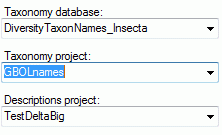
By starting a query (button  Check for
differences, Check for identical names or Start check) you
will get a result list of database entries that can be updated (see
image below). In this example the first result entry represents two
datasets in Diversity Descriptions (column Number). In column
DescriptionIds the range of the affected database internal IDs is
shown. You may select or deselect single entries of the result list for
the database update in column OK.
Check for
differences, Check for identical names or Start check) you
will get a result list of database entries that can be updated (see
image below). In this example the first result entry represents two
datasets in Diversity Descriptions (column Number). In column
DescriptionIds the range of the affected database internal IDs is
shown. You may select or deselect single entries of the result list for
the database update in column OK.

The size of the query result list may be adapted by changing the value
Number of results or unchecking this option to get the complete list
(see image below). If datasets of Diversity Descriptions are not yet
linked to another module, the query in Diversity Descriptions may be
restricted by specifying a value in the field Restrict to names
starting with. You may select or deselect all entries of the result
list for the database update by clicking the buttons
 Select all rsp.
Select all rsp.  Select none.
Select none.
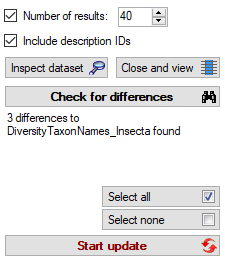
If you select the option Include description IDs the buttons
Inspect dataset  and Close and view
and Close and view
 will be shown. By starting a new query
(button
will be shown. By starting a new query
(button  ) the result list will now include the
columns Description and DescriptionID instead of
DescriptionIds and Number (see image below). Furthermore each
dataset entry will now be shown in an own result line.
) the result list will now include the
columns Description and DescriptionID instead of
DescriptionIds and Number (see image below). Furthermore each
dataset entry will now be shown in an own result line.
 ?class=inlineimg
By selecting an entry in the result table and clicking the button
Inspect dataset
?class=inlineimg
By selecting an entry in the result table and clicking the button
Inspect dataset  you may view the dataset in a
sepate window. With button Close and view
you may view the dataset in a
sepate window. With button Close and view  you can close the maintenance form without changing the database and
view or edit all enteries that are checked in column “OK” of the result
table in the main program window.
you can close the maintenance form without changing the database and
view or edit all enteries that are checked in column “OK” of the result
table in the main program window.
Subsections of Synchronize
Maintenance
Broken Links
Broken links to other databases occur when the database’s name has been
change or if it was moved to a different server. To find and repair
broken links to the modules of the Diversity Workbench select the
 Synchronize databases tab and choose the
tab
Synchronize databases tab and choose the
tab  Broken links. The meaning of some
generally used controls is explained in the introduction page of
database synchronization.
Broken links. The meaning of some
generally used controls is explained in the introduction page of
database synchronization.
Select the Link type, e.g. “Taxon name” to search broken links to
DiversityTaxonNames and the Descriptions project. Select the
Search for broken links option and start the query with a click on
the Search for broken links  button. If the
link type “Geographic area” or “Specimen” has been selected, an
additional selection box for the Descriptions table appears, where
you may select from “Description
scope” or " Sampling
event" rsp. " Sampling
unit". Each link of the
selected type and project will checked if it can be connected to the
referenced database and unsuccessful connection attemts will be listed
in the data grid view (see image below).
button. If the
link type “Geographic area” or “Specimen” has been selected, an
additional selection box for the Descriptions table appears, where
you may select from “Description
scope” or " Sampling
event" rsp. " Sampling
unit". Each link of the
selected type and project will checked if it can be connected to the
referenced database and unsuccessful connection attemts will be listed
in the data grid view (see image below).
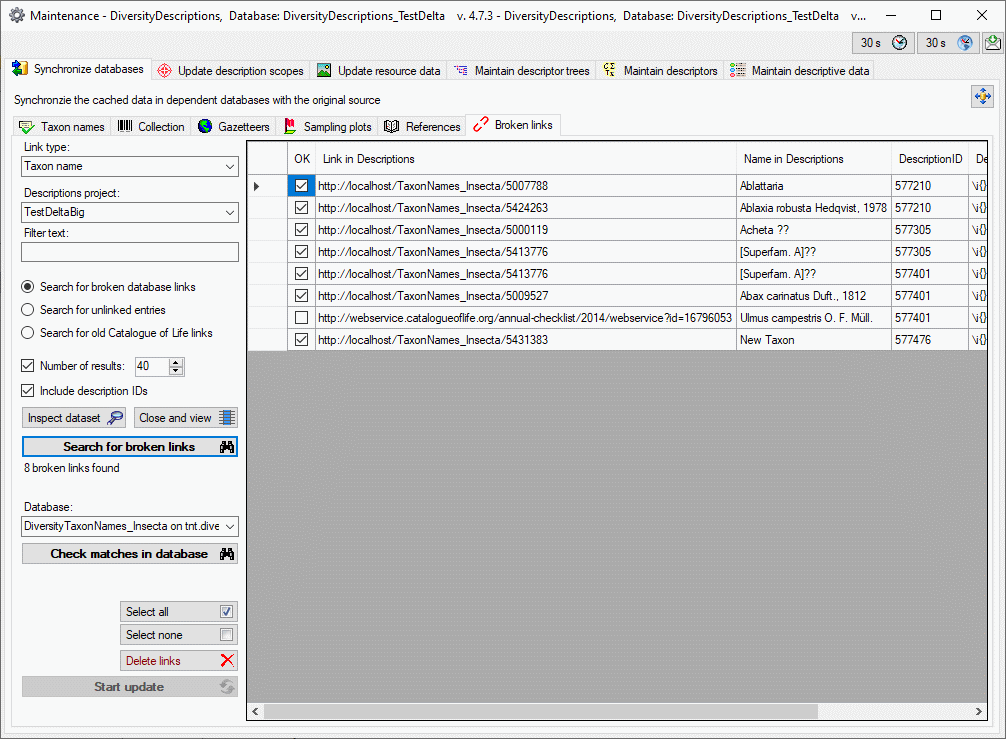
Keep in mind that the connection check might be unsuccessful for remote
databases, if the database connection was not set up before!
If you prefer to remove some broken links, you may now select them and
then click button  . If you want to connect the
links to a database, chose the new target in combo box Database and
click the Check matches in database
. If you want to connect the
links to a database, chose the new target in combo box Database and
click the Check matches in database  button.
The check is successful, if the new databese contains an entry with the
same ID and display text and the results will be selected and shown with
white background (see image below).
button.
The check is successful, if the new databese contains an entry with the
same ID and display text and the results will be selected and shown with
white background (see image below).
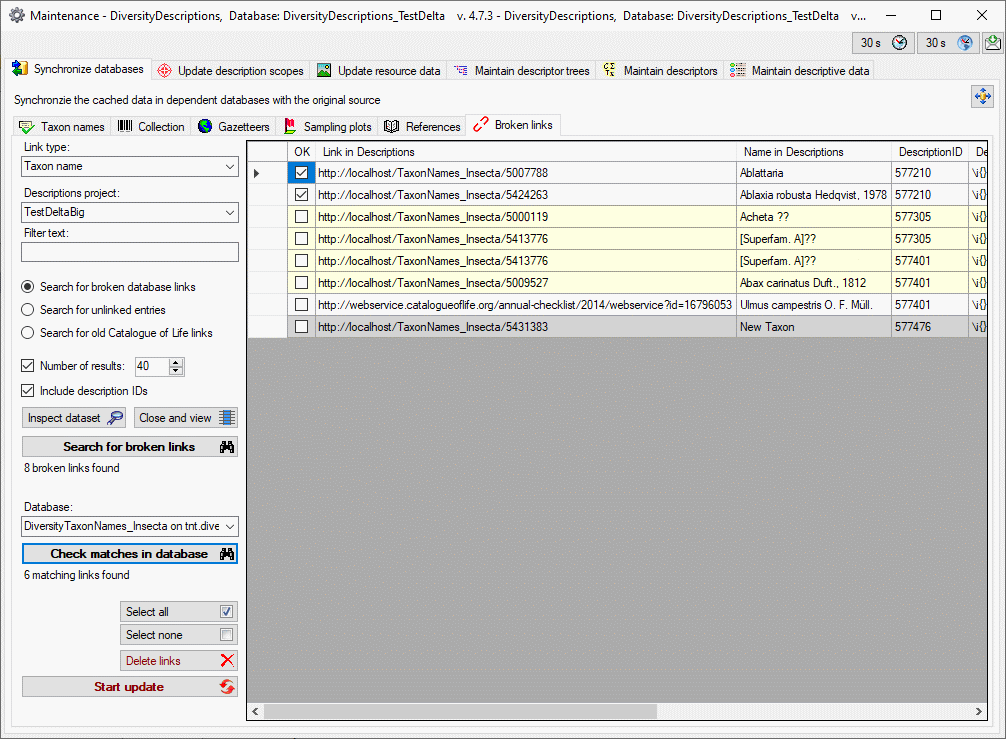
If in the new database a matching link was found but the display text
differs, the entries are marked with yellow
background. For these lines you should check the “New name”
column and if the found entry is applicable you may select the entry for
update. If no matching entry in the database was found, it is marked
with grey background (see image above). To
update the database click on the  button.
button.
Delete unlinked scope entries
As an additional option you may search for unlinked scope entries and
remove them completely from the database. Select the option Search for
unlinked entries and then click on the Search for broken links
 button. Select the entries you want to delete
and click button
button. Select the entries you want to delete
and click button  (see image below).
(see image below).
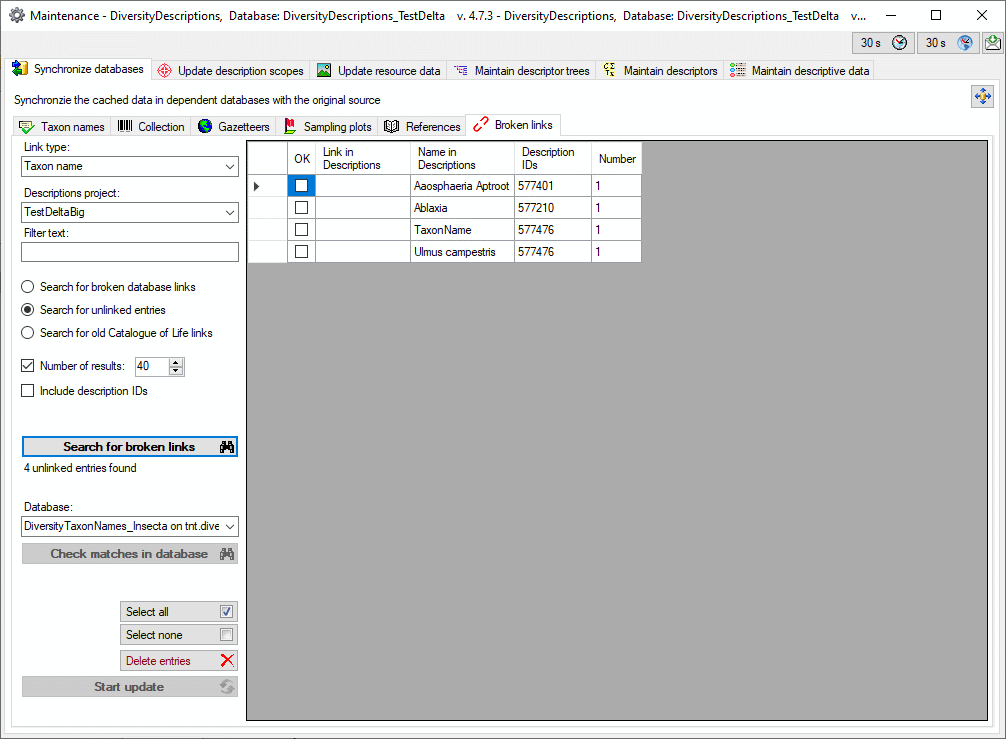
Find and correct links to old “Catalogue of Life” webservices
The webservice “Catalogue of Life” was changed several times. Links to
old versions are not readable anymore, therefore new matching entries
have to be found. Select the option Search for old Catalogue of Life
links and then click on the Search for broken links
 button. If you only want to remove the invalid
links and keep the unlinked scope entry, click on button
button. If you only want to remove the invalid
links and keep the unlinked scope entry, click on button
 (see image below).
(see image below).
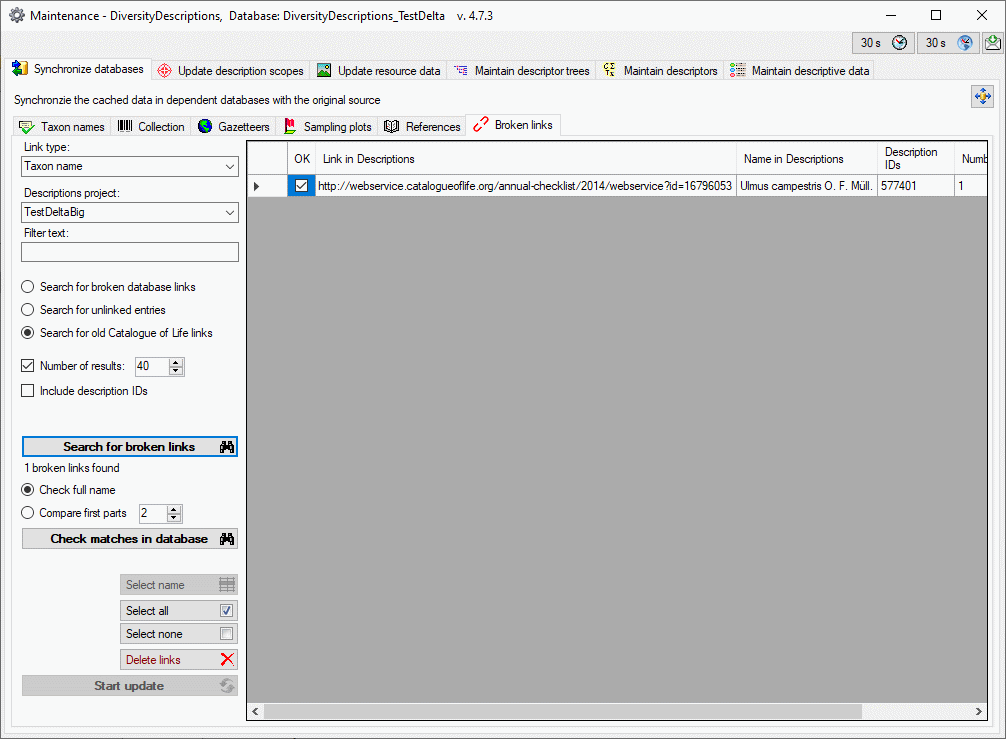
To find matching entries in the current webservice, select a option
Check full name or Compare first parts and click on the Check
matches in the database  button. If the name in
your data does not match the name in the webservice perfectly, it will
be marked with a yellow background. If
no name matches exactly and there are several entries, the line is
marked with blue background (see image
below).
button. If the name in
your data does not match the name in the webservice perfectly, it will
be marked with a yellow background. If
no name matches exactly and there are several entries, the line is
marked with blue background (see image
below).
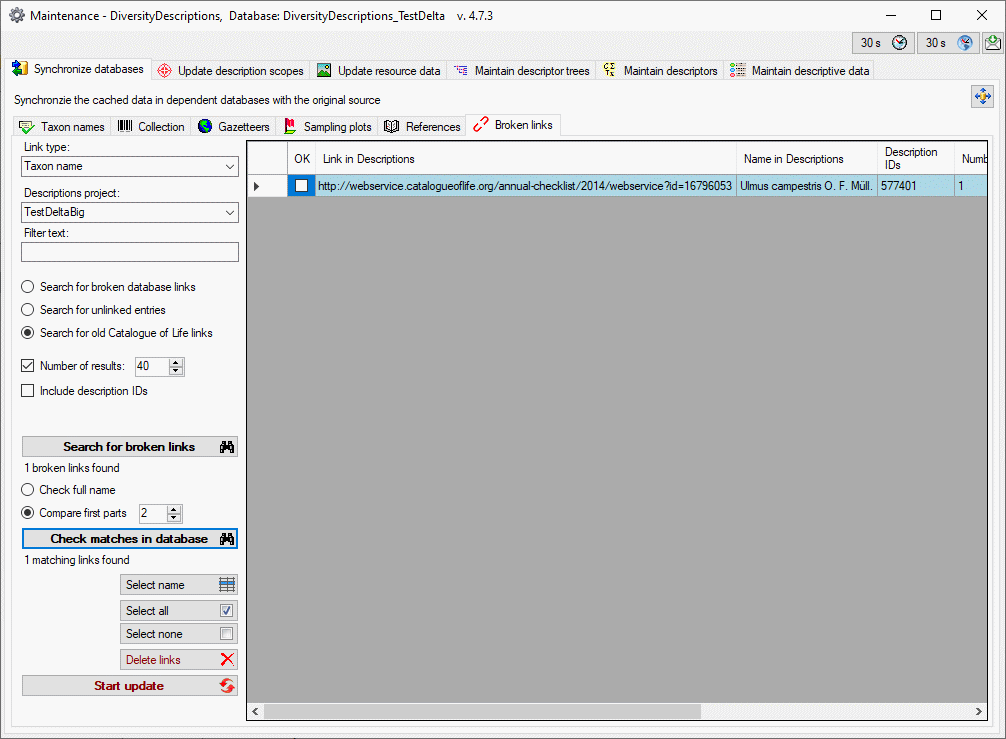
You have the option to select the best match by a click on button
Select name  (see image below).
(see image below).
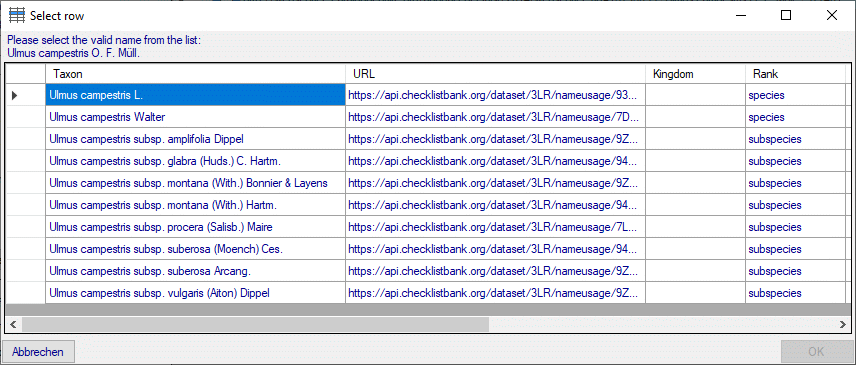
Finally, click on the  button to enter the
results in the database.
button to enter the
results in the database.
Maintenance
Collection
To synchronize the entries for the specimen or observations derived from
the module DiversityCollection select the  Synchronize databases tab and choose the tab
Synchronize databases tab and choose the tab
 Collection.
There are two ways to synchronize specimen and observations. You may
either
Collection.
There are two ways to synchronize specimen and observations. You may
either  Synchronize entities with a
link to DiversityCollection for entries where the link to a taxonomic
database is already established or you may
Synchronize entities with a
link to DiversityCollection for entries where the link to a taxonomic
database is already established or you may  Synchronize entities missing a link to DiversityCollection where no
link is established and you can query for identical names in one of the
databases. The meaning of some generally used controls is explained in
the introduction page of database
synchronization.
Synchronize entities missing a link to DiversityCollection where no
link is established and you can query for identical names in one of the
databases. The meaning of some generally used controls is explained in
the introduction page of database
synchronization.
 Synchronize entities with a link to
DiversityCollection
Synchronize entities with a link to
DiversityCollection
The specimen and observations are stored as field “label” of table
DescriptionScope, where
the scope type Specimen
or Observation
specified. Alternatively the field collection_specimen of table
SamplingUnit can be updated.
Select a collection database, the descriptions project and the scope
type that shall be synchronized. Start the query with a click on
the  button.
button.
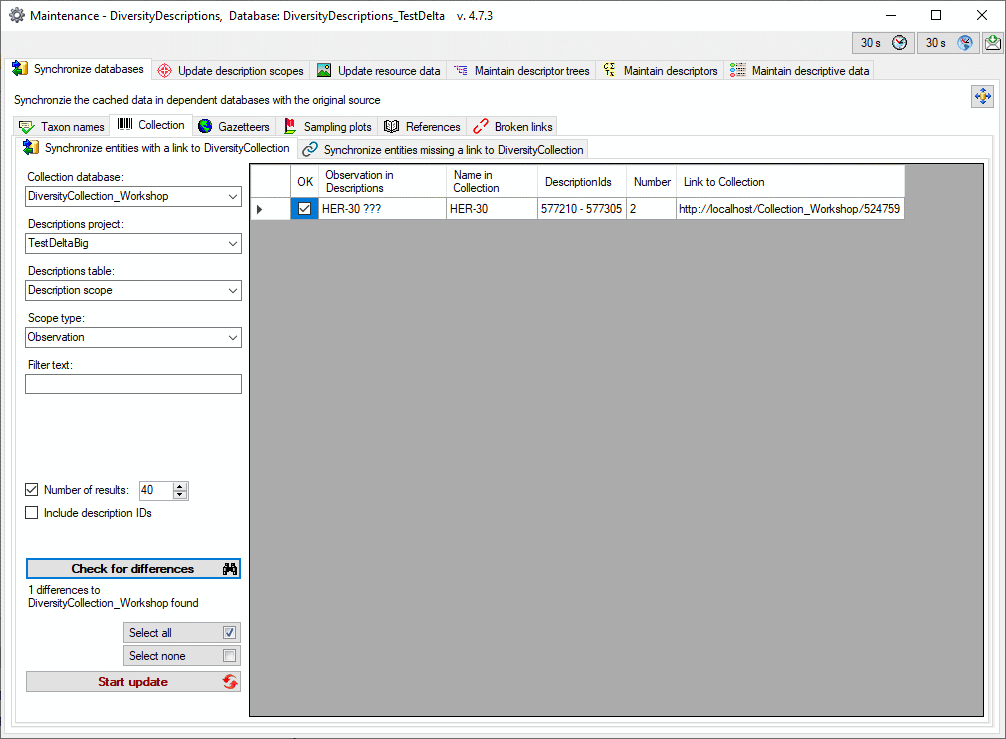
The form will list all differences found. To update the database click
on the  button.
button.
 Synchronize entities missing a link to
DiversityCollection
Synchronize entities missing a link to
DiversityCollection
Select the collection database, optionally a project within this
database, a project in the descriptions database, the descriptions teble
and the scope type
Specimen or Observation to search for
identical names. Start the query with a click on the
 button. To use these similar names check them
in the OK column.
button. To use these similar names check them
in the OK column.
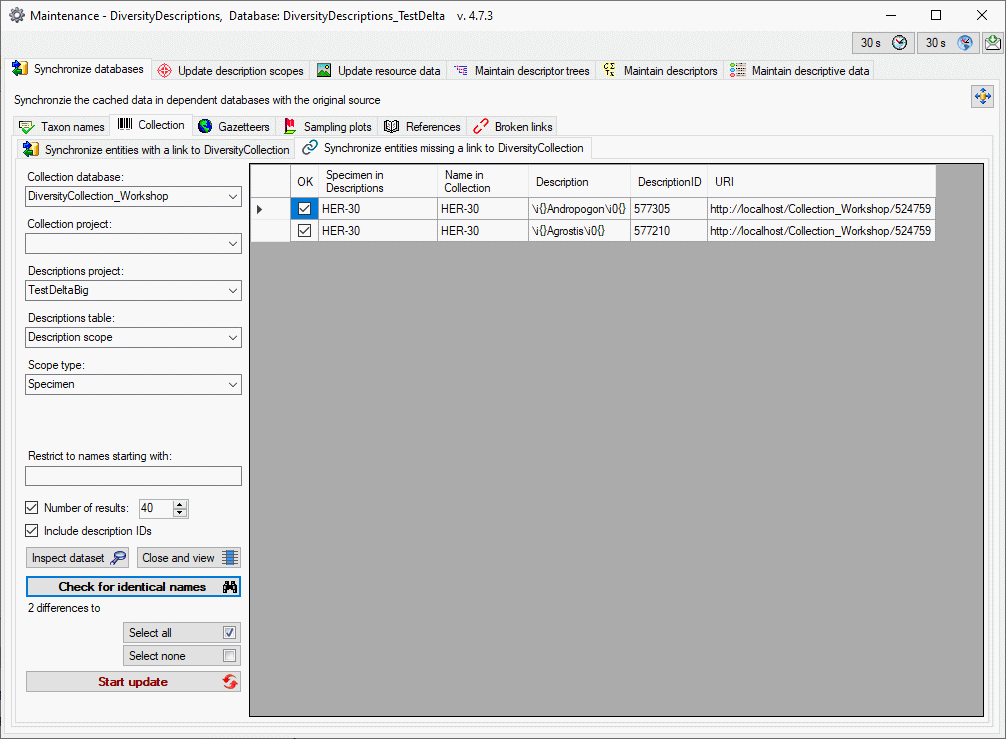
The form will list all matches found. To insert the links to the
database click on the  button.
button.
Maintenance
Gazetteer
To synchronize the entries for the geographic places derived from the
module DiversityGazetteers select the  Synchronize databases tab and choose the tab
Synchronize databases tab and choose the tab  Gazetteers. There are two ways to synchronize geographic names. You
may either
Gazetteers. There are two ways to synchronize geographic names. You
may either  Synchronize places linked
to DiversityGazetteers for entries where the link to a gazetteers
database is already established or you may
Synchronize places linked
to DiversityGazetteers for entries where the link to a gazetteers
database is already established or you may  Synchronize places missing a link to DiversityGazetteers where no link
is established and you can query for identical names in one of the
databases. The meaning of some generally used controls is explained in
the introduction page of database
synchronization.
Synchronize places missing a link to DiversityGazetteers where no link
is established and you can query for identical names in one of the
databases. The meaning of some generally used controls is explained in
the introduction page of database
synchronization.
 Synchronize places linked to
DiversityGazetteers
Synchronize places linked to
DiversityGazetteers
The geographic names are stored as field “label” of table Descriptionscope with the scope type
GeographicArea or in
field “geographic_area” of table
SamplingEvent. Select a
gazetteers database, the descriptions project and the descriptions table
that shall be synchronized. Start the query with a click on
the  button.
button.
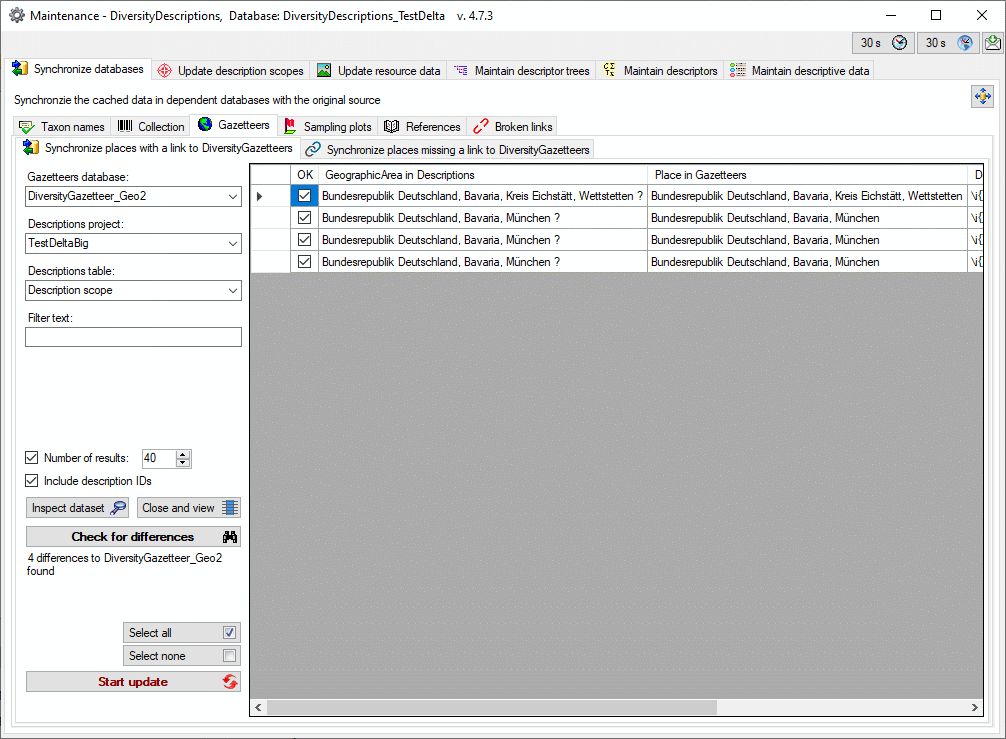
The form will list all differences found. To update the database click
on the  button.
button.
 Synchronize places missing a link to
DiversityGazetteers
Synchronize places missing a link to
DiversityGazetteers
Select the gazetteers database, optionally a project within this
databas, a project in the descriptions database and the descriptions
table to search for identical names. Start the query with a click on the
 Start check button. To use these similar
names check them in the OK column.
Start check button. To use these similar
names check them in the OK column.
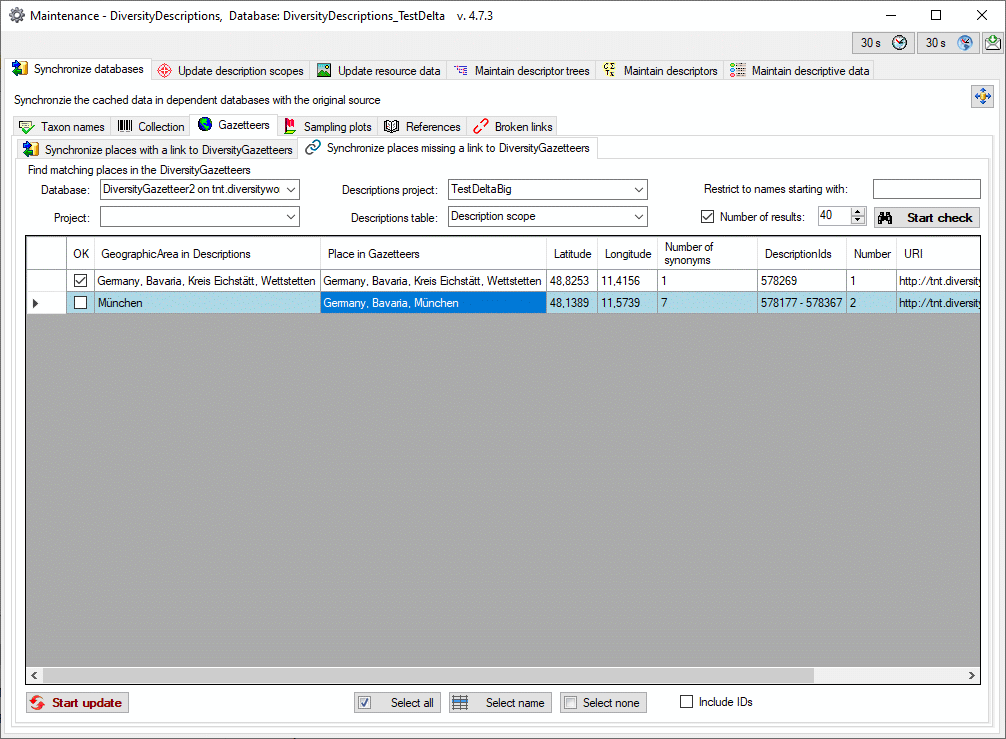
Many places have identical names in different regions. Names where
several results were found are marked in blue. To choose the correct
name among the list of results, click on the  Select name button and select the correct name from the list as
shown below.
Select name button and select the correct name from the list as
shown below.
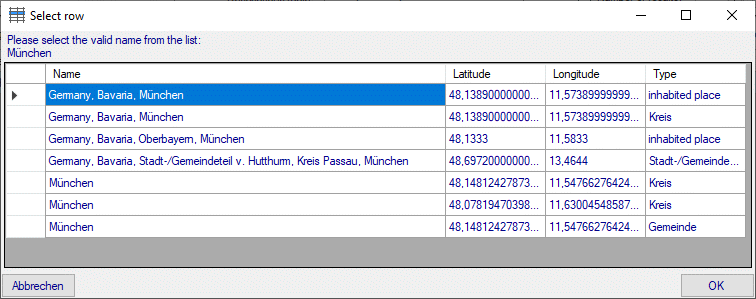
Finally, click on the  button to enter the
results in the database.
button to enter the
results in the database.
Maintenance
References
To synchronize the titles of the references which are linked to the
module DiversityReferences select the  Synchronize databases tab and choose the tab
Synchronize databases tab and choose the tab
 References. Select the references database
and the project for which the reference titles should be synchronized.
The references are stored as field “label” of table
DescriptionScope, where
the scope type Citation
is specified. The meaning of some generally used controls is explained
in the introduction page of database
synchronization.
References. Select the references database
and the project for which the reference titles should be synchronized.
The references are stored as field “label” of table
DescriptionScope, where
the scope type Citation
is specified. The meaning of some generally used controls is explained
in the introduction page of database
synchronization.
Start the query with a click on the  button.
button.
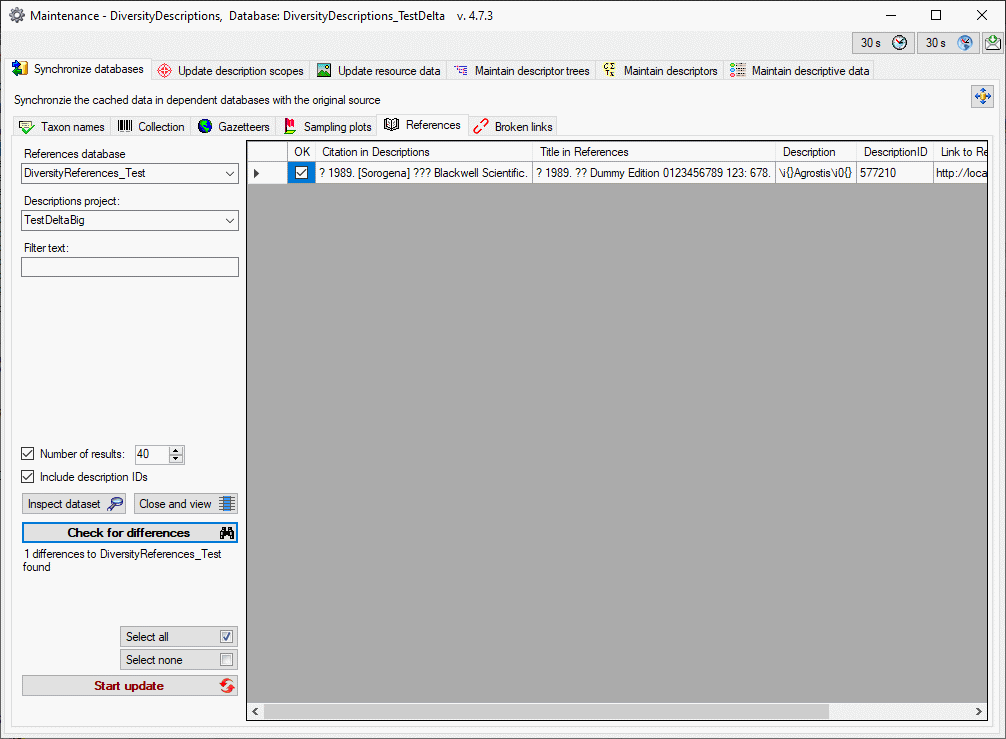
The form will list all differences found. To update the database click
on the  button.
button.
Maintenance
Sampling Plots
To synchronize the titles of the references which are linked to the
module DiversityReferences select the  Synchronize databases tab and choose the tab
Synchronize databases tab and choose the tab
 Sampling plots. Select the references
database and the project for which the reference titles should be
synchronized. The references are stored as field “label” of table
DescriptionScope, where
the scope type Citation
is specified. The meaning of some generally used controls is explained
in the introduction page of database
synchronization.
Sampling plots. Select the references
database and the project for which the reference titles should be
synchronized. The references are stored as field “label” of table
DescriptionScope, where
the scope type Citation
is specified. The meaning of some generally used controls is explained
in the introduction page of database
synchronization.
Start the query with a click on the  button.
button.
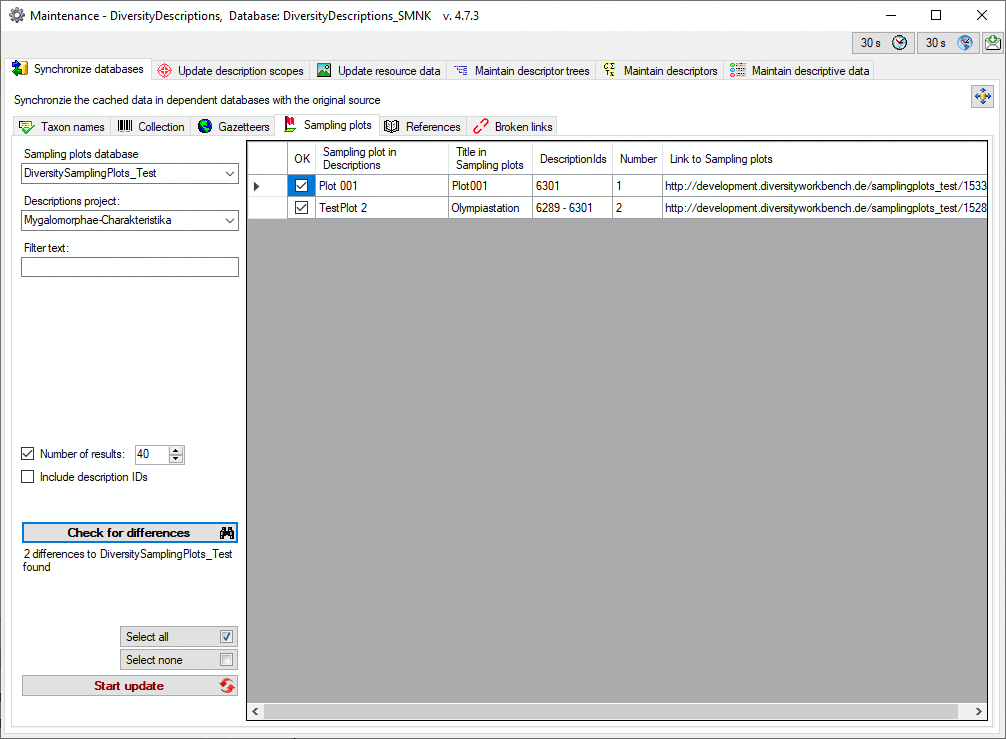
The form will list all differences found. To update the database click
on the  button.
button.
Maintenance
Taxon Names
To synchronize the entries for the taxonomic names derived from the
module DiversityTaxonNames select the  Synchronize databases tab and choose the tab
Synchronize databases tab and choose the tab  Taxon names. There are two ways to synchronize taxonomic names. You
may either
Taxon names. There are two ways to synchronize taxonomic names. You
may either  Synchronize taxonomic names
linked to an external data source for entries where the link to a
taxonomic database is already established or you may
Synchronize taxonomic names
linked to an external data source for entries where the link to a
taxonomic database is already established or you may
 Synchronize taxonomic names missing a
connection where no link is established and you can query for
identical names in one of the databases. The meaning of some generally
used controls is explained in the introduction page of database
synchronization.
Synchronize taxonomic names missing a
connection where no link is established and you can query for
identical names in one of the databases. The meaning of some generally
used controls is explained in the introduction page of database
synchronization.
 Synchronize taxonomic names linked to an
external data source
Synchronize taxonomic names linked to an
external data source
The taxonomic names are stored as field “label” of table
DescriptionScope, where
the scope type TaxonName
is specified. Select a
taxonomy database and the descriptions project that shall be
synchronized. Start the query with a click on
the  button.
button.
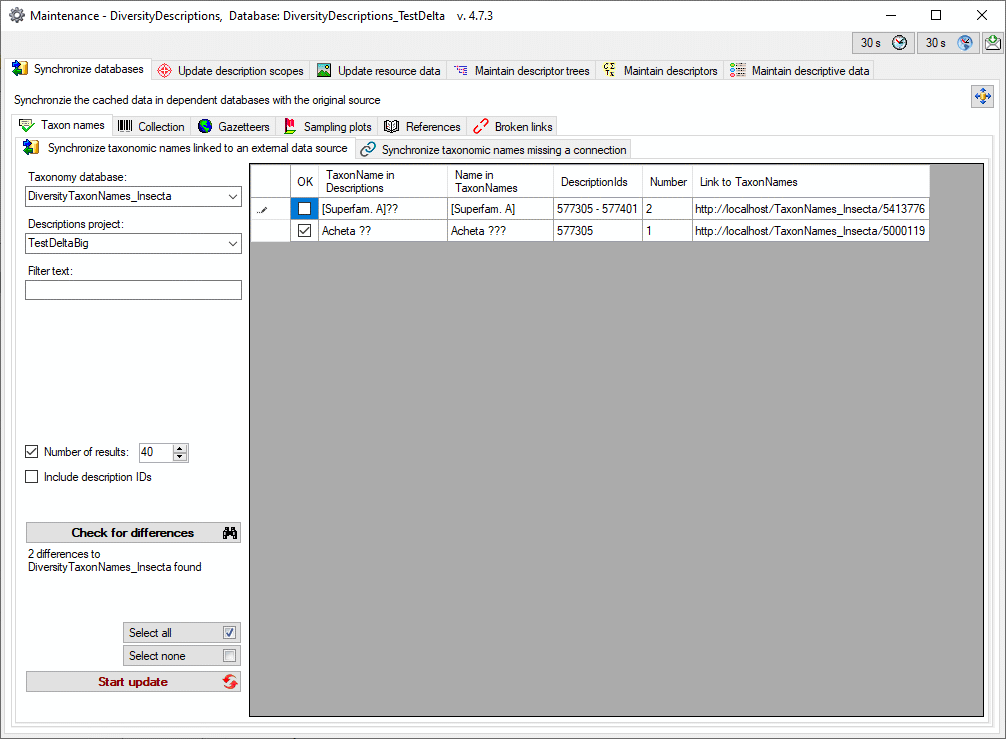
The form will list all differences found. To update the database click
on the  button.
button.
 Synchronize taxonomic names missing a
connection
Synchronize taxonomic names missing a
connection
Select a taxonomic database, optionally a project within this database
and a project in the descriptions database to search for identical
names. Start the query with a click on the
 button. You may either restrict the search to
an exact match (= Compare whole name) or to the first parts of the
name (= Compare first parts) as shown below. If the names do not
match exactly, you may either update the name (= Update similar
name) in the descriptions database or import the name from the
DiversityTaxonNames as a new scope (= Insert as new name - see
options in the window depicted below). In the result list only matching
names will be checked (column OK). The other results will be marked
indicating the difference. Yellow indicates a difference in the authors
while red indicates differences in main parts of the name. To use these
similar names check them in the OK column.
button. You may either restrict the search to
an exact match (= Compare whole name) or to the first parts of the
name (= Compare first parts) as shown below. If the names do not
match exactly, you may either update the name (= Update similar
name) in the descriptions database or import the name from the
DiversityTaxonNames as a new scope (= Insert as new name - see
options in the window depicted below). In the result list only matching
names will be checked (column OK). The other results will be marked
indicating the difference. Yellow indicates a difference in the authors
while red indicates differences in main parts of the name. To use these
similar names check them in the OK column.
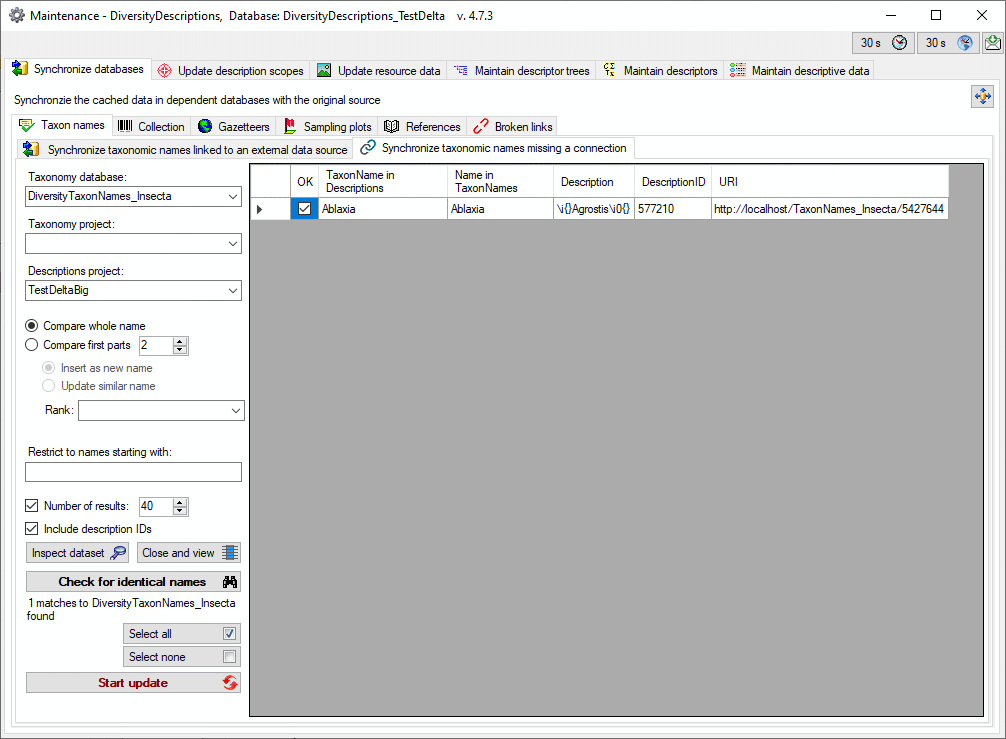
The form will list all matches found. To insert the links to the
database click on the  button.
button.
Synchronize taxonomic names missing a connection with a websrvice
To synchronize the taxonomic names with a webservice
select it as Taxonomy database. You may either compare the entire
name or the first parts of the name (see image below and description
above). If the name in your data does not match the name in the
webservice perfectly, the name will be marked with a yellow background.
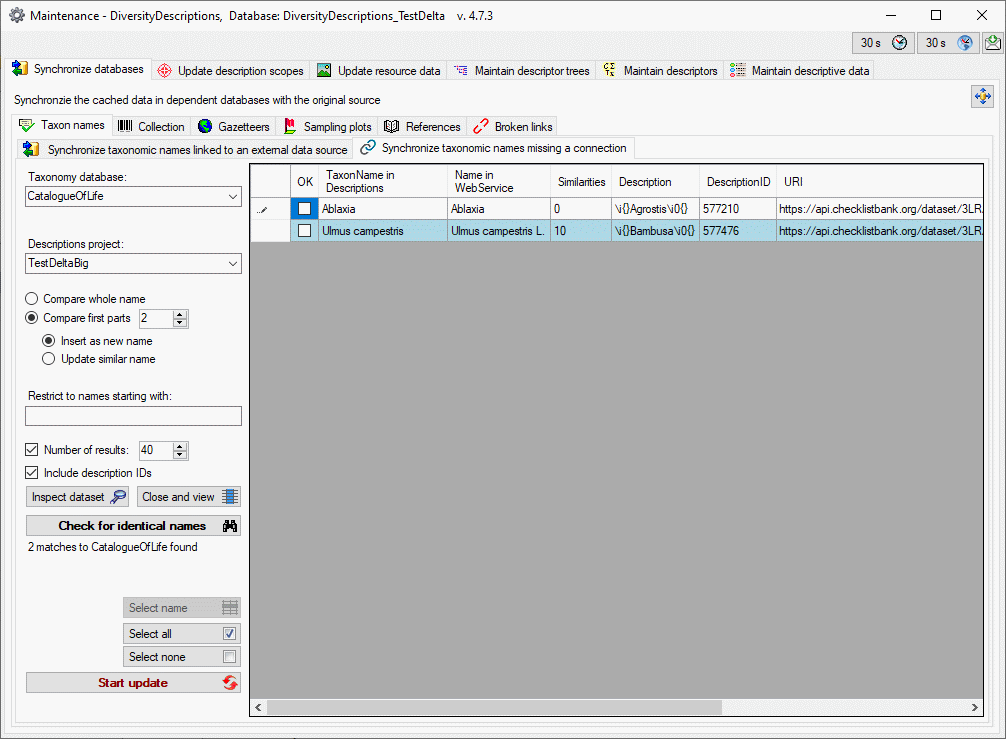
If several similar names were found, these lines will be marked with a
blue background (see image above). To
select one of the similar names click on the Select name
 button. A window will open as shown below
listing all similar names found in the webservice. Select one name and
click OK to use it.
button. A window will open as shown below
listing all similar names found in the webservice. Select one name and
click OK to use it.
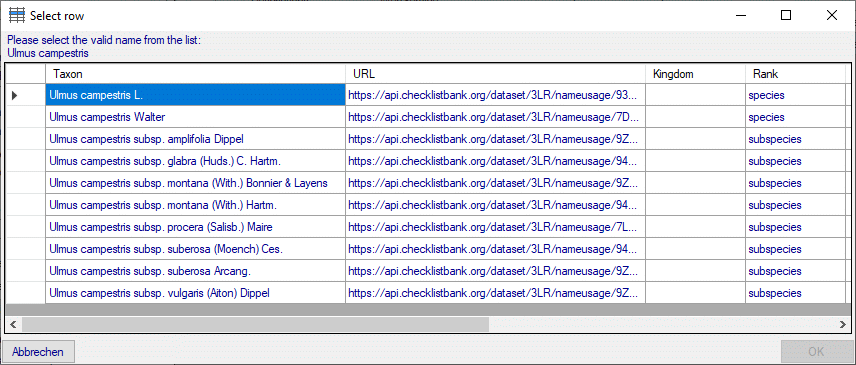

 Maintenance … from the menu and
select the
Maintenance … from the menu and
select the 
 taxonomic names,
taxonomic names,













 and Close and view
and Close and view
 will be shown. By starting a new query
(button
will be shown. By starting a new query
(button 
 ?class=inlineimg
By selecting an entry in the result table and clicking the button
Inspect dataset
?class=inlineimg
By selecting an entry in the result table and clicking the button
Inspect dataset  you may view the dataset in a
sepate window. With button Close and view
you may view the dataset in a
sepate window. With button Close and view  you can close the maintenance form without changing the database and
view or edit all enteries that are checked in column “OK” of the result
table in the main program window.
you can close the maintenance form without changing the database and
view or edit all enteries that are checked in column “OK” of the result
table in the main program window. 
 . If you want to connect the
links to a database, chose the new target in combo box Database and
click the Check matches in database
. If you want to connect the
links to a database, chose the new target in combo box Database and
click the Check matches in database 
 button.
button. (see image below).
(see image below).


 (see image below).
(see image below).
 Collection.
There are two ways to synchronize specimen and observations. You may
either
Collection.
There are two ways to synchronize specimen and observations. You may
either  Synchronize entities missing a link to DiversityCollection where no
link is established and you can query for identical names in one of the
databases. The meaning of some generally used controls is explained in
the
Synchronize entities missing a link to DiversityCollection where no
link is established and you can query for identical names in one of the
databases. The meaning of some generally used controls is explained in
the  button.
button.
 button. To use these similar names check them
in the OK column.
button. To use these similar names check them
in the OK column. 










